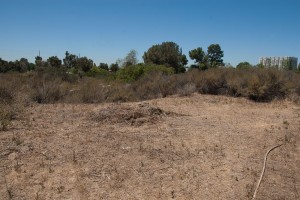This past Saturday, volunteers set up a soil solarization trial at the BFS. The area to be solarized was cleared of rocks and vegetation and covered with clear plastic, which will be left in place for 2–3 months. The plastic will trap heat generated by solar radiation (the greenhouse effect), causing soil temperature to rise high enough to kill weed seeds present in the soil. When properly done, the top 6 inches of the soil will heat up to as high as 140°F.
This is the first time we’ve tried this technique at the BFS, and if it works well we may try it in other areas in the future. The area we chose for the trial was almost entirely covered with mustard and Italian Thistles. It’s also fairly flat and has a convenient water source nearby, which facilitated setting up the solarization. Because essentially no native plants are present in this area, we should be able reduce the seed bank of the invasive thistles and mustards without adversely affecting the native seed bank.
Volunteers had previously cleared weeds from this area, and before we started it looked like this:
Before the volunteers arrived, the soil had been irrigated to depth of at least 8 inches. Their first step was to remove rocks and stumps of the mustard and thistles:
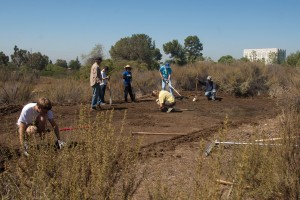
Bryan Visser (HMC ’13), Tim Cox, Carol Cox, Valerie Evans, Anne Clark (HMC ’13), and Elliott Cox remove plant material and rake the soil. ©Nancy Hamlett.
The volunteers then raked the area smooth and dug a trench around the perimeter for burying the edges of the plastic:
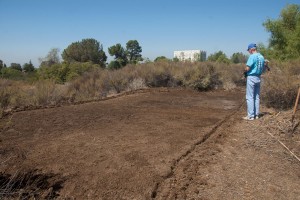
Richard Haskell inspects the cleaned-up area with the perimeter trench ready for plastic. ©Nancy Hamlett.
The next step was to lay two layers of clear plastic sheeting:
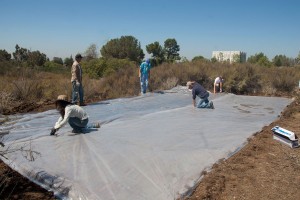
Carol Cox, Tim Cox, Richard Haskell, Elliott Cox, and Bryan Visser (HMC ’13) spread the plastic. ©Nancy Hamlett.
The edge of the plastic was buried in the trench to seal it, and dirt was used to seal a seam in the middle:
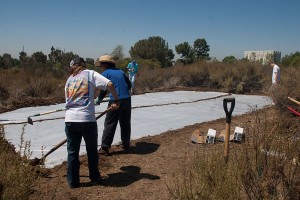
Anwen Evans, Valerie Evans, Richard Haskell, and Bryan Visser (HMC ’13) cover the edges of the plastic with soil. ©Nancy Hamlett.
Lastly, they erected a temporary chicken wire fence to discourage critters from playing slippy slide on our plastic.

Bryan Visser (HMC ’13), Richard Haskell, and Anne Clark (HMC ’13) stretch out the chicken wire. ©Nancy Hamlett.

Tim Cox, Richard Haskell, Bryan Visser (HMC ’13), and Anne Clarke (HMC ’13) put in the last fence supports. ©Nancy Hamlett.
The volunteers admire their handiwork:
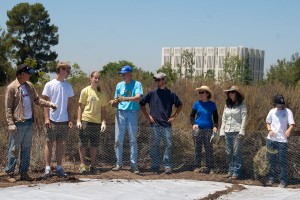
Tim Cox, Bryan Visser (HMC ’13), Anne Clarke (HMC ’13), Richard Haskell, Elliott Cox, Valerie Evans, Carol Cox, and Anwen Evans behind the completed solarization setup. ©Nancy Hamlett.
We won’t know how well the solarization worked until next spring when we can see how many weeds come up here compared to untreated areas, so stay tuned for updates.
If you’re interested in learning more about soil solarization, the University of California has a lot of information on the web; here’s a good place to start: http://ucanr.org/sites/Solarization/.
